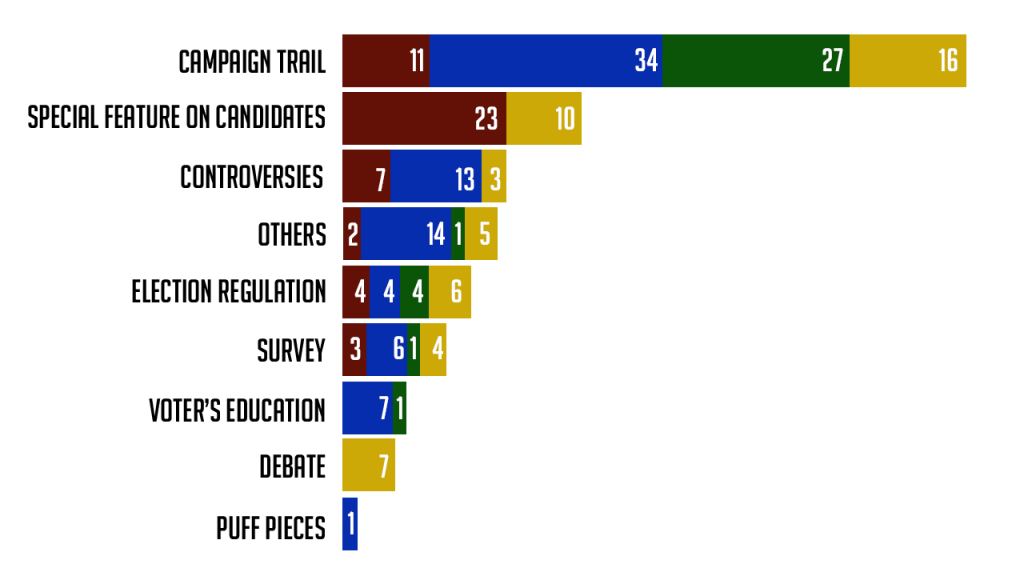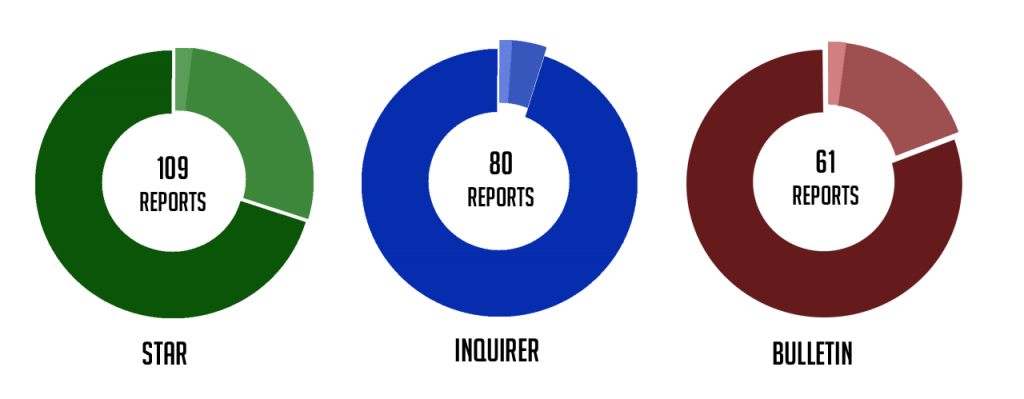Silent on Local Polls: TV Still Hot on the National Campaign Trail, Puff Pieces Still Dominate Print

THE LOCAL campaign kickoff on March 29 helped increase election-related reports, but brought little improvement to the reportage on the campaign. Most of the reports on TV were still on the campaign sorties of the candidates for the Senate, with little focus on local elections and candidates across the nation, while puff pieces continued to flourish in the broadsheets.
The focus on the Senate is understandable. Voters see the Senate as the only arena in which the principle of check-and-balance can be tested and where their ballot can make a significant difference in terms of moving forward on either side of the party lines. Media’s emphasis on senatorial campaign makes sense. Also, the monitor reviews the media based mainly in Metro Manila, the resources of which are focused on serving a so-called national audience. Only the local elections in the areas of the National Capital Region (NCR) capture the interest of these news platforms up until the election day.
From a long term view, this limited scope of the national press prevents the electorate to sense the importance of local elections, where officials enjoy more power and hold pockets of immense resources at their disposal. Ordinary citizens feel government through the local government units (LGUS).
In a sense, national news organizations prioritize developments in Metro Manila more specifically. Their stories do not track the emergence of local dynasties in different provinces for a national audience.
The story of the “boss” in Davao city was picked up because of the concern about the use of death squads. There was no pick up on the signs of his political family growing to the point that Sara Duterte would wield so much national power as to manipulate the alliances in the House of Representatives, to dislodge Rep. Pantaleon Alvarez (Davao del Norte, 1st District), her father’s choice for House Speaker, thus restoring Gloria Macapagal Arroyo to political eminence.
CMFR monitored the reporting of Manila broadsheets (Philippine Daily Inquirer, The Philippine Star, and Manila Bulletin) and primetime newscasts (ABS-CBN 2’s TV Patrol, GMA-7’s 24 Oras, TV5’s Aksyon, and CNN Philippines’ News Night) and select news websites from March 13 to April 12
PRIMETIME NEWSCASTS
Among primetime newscasts, TV Patrol allotted the most airtime to the elections, with 4 hours and 10 minutes or 17.49 percent of the total running time (TRT); followed by Aksyon, one hour and four minutes or 12.82 percent of the TRT; News Night, one hour and 48 minutes or 11.19 percent; and 24 Oras, 53 minutes or 4.03 percent.

NOTE: Aksyon has no primetime newscasts during weekends.
Still on the Campaign Trail
With elections just around the corner, the media were still in hot pursuit of the candidates for national office and their political parties as they campaigned across the nation. On the day of the kick-off for the campaign for local posts, the reports spiked as primetime newscasts covered proclamation rallies across Metro Manila and other major cities; but media interest on the local polls faded quickly.
Coverage of the local campaign in the provinces paled in comparison to the national campaign, with national media focusing only on Metro Manila candidates. For the most part, local politicians in the provinces only made news if they were able to forge alliances with national parties. Reports on controversial local politicians like Sara Duterte and the Binay siblings in Makati were the exceptions; but other local politicians were hardly visible in the national media.
The dismal media attention to the local campaigns prevents public understanding of the dominance in local politics of the political dynasties in the provinces, where in some cases like-minded dynasts were running unopposed or were running against each other.

Special Features
Some primetime newscasts did produce special features on election-related issues. News Night aired stories tackling the millenial vote, religious endorsements, vote-buying and personality politics. TV Patrol aired a story on the unfair advantage of candidates with huge campaign funds and machineries. Its #HalalanHugot man-on-the-street series reported on the issues voters wanted politicians to address such as health and education. TV Patrol also looked into the major issues in several cities including poverty in Quezon City, informal settlers in San Juan and drugs in Caloocan City, noting local politicians’ stand on these issues. Aksyon also interviewed lesser known candidates in its Aplikante sa Senado (Senate Applicant) segment, giving them airtime to introduce themselves and their platform.
PRINT COVERAGE
As in CMFR’s previous election monitor, The Philippine Star published the most number of election-related reports at 109, of which 32 were on the front page including two banner stories. The Inquirer had 80, four with front page leads of which one was a banner story. The Bulletin had 12 front page reports out of 61, one banner story.

Puff Pieces
Puff pieces — items such as a candidate’s “getting a warm welcome” during one of his sorties that were not news-worthy but which kept the subjects in the public mind — were dominant in print during the monitored period. Christopher “Bong” Go led with a total of 17 such pieces, of which The Star published 10. He was followed by Marcos, Tolentino and Angara who each had three.
The start of the local campaign period also saw some local candidates getting media mileage; such as Joy Belmonte (running as Quezon City mayor), Alfredo Lim (running as Manila City mayor), Abby and Junjun Binay (both running as Makati City mayor) . Reports on these candidates were on their plans for their respective cities and, in the case of the Binays, the infighting among family members. (see charts below)

Top 10 Candidates for Senatorial Elections with
Most Numbers of Puff Pieces

As in broadcast, there were also significantly more reports in print on candidates for national office compared to those running for local posts. These rare reports on the local polls were relegated to the inside pages.
Top 4 Candidates for Local Elections with Most Number of Puff Pieces

Others
Following the puff pieces in number were stories on election-related violence, endorsements from the religious sector and preparations for overseas voting. Print did not publish special features on election-related topics.
Initiatives Online
In its previous election monitor, CMFR pointed out weaknesses in the coverage such as the lack of reports aimed at educating voters on the issues. As the May 13 election draws near, some effort has been made in online media to do so. The old media of print and broadcast also used social media platforms to widen their reach.
One such initiative was the Bulletin’s #MatalinongBoto2019, which produced short videos on the perils of vote-buying. It was posted in the broadsheet’s Facebook page. ABS-CBN News also released #HalalanDaily, a series of infographics on the elections.
PhilStar.com tracked developments in the preparations for elections through its As It Happens special. Online news site Interaksyon published a series of explainers that analyzed the results of polls on the senatorial candidates. BothGMA News online and Rappler have microsites dedicated to the elections that feature candidates’ profiles and other guides for voters.
While social media is a useful tool in educating voters, it is easily used to manipulate public opinion through disinformation and propaganda. The Comelec’s online monitoring and regulation is still limited.
Silent on Issues
With only a month left before the elections, most reports remain inadequate and superficial. Much of the coverage still focus on the prominent candidates and those involved in controversies, sidelined both the less prominent who have something to say on the issues, and the equally important local polls.
While the focus was on the senatorial contest, reports lacked significant inputs that will prod citizens to consider their choices. There was a lack of stories on the importance of the role of the senate in national government, reporting on how this institution has served as a forum in which local and national issues were discussed with substance and vigor. As coverage seemed locked in the vise of news conventions, there was an unfortunate lack of analytical pieces that discussed the Senate as an institution that should understand the requirements of national interest without losing appreciation for the sectoral as well as regional needs of its national constituency. There were no updates on the current state of national politics, documenting the capture of the House by the president’s political allies, including those in the party list; and how Senate remains as the only potential force to check tendencies toward one-man-one-party rule.
The results of the local polls will determine the composition of the House of Representatives. With local politics making up the national political base, the outcome in the House remains crucial in the outcome of the next presidential elections. The electorate requires more in-depth reports from the media to enable it to make informed choices come May 13.
Unfortunately, CMFR does not have the resources to review community-based reports. At this level, the media should be watched and evaluated as well. It could have more impact on the voters given the immediacy of its connection and its access to sources of news. Whether or not it is serving the needs of the electorate is alas, beyond our current capacity to call.
Leave a Reply